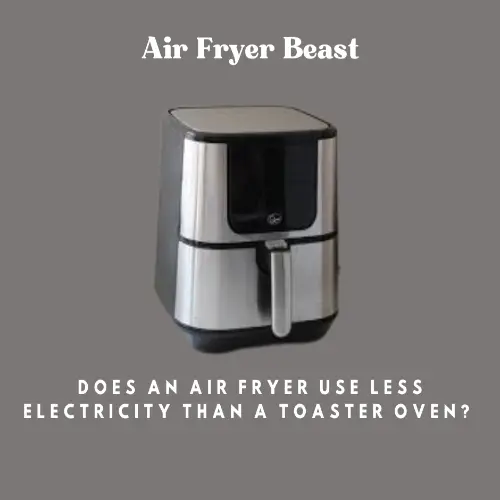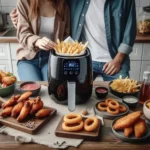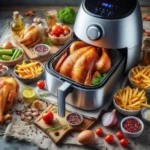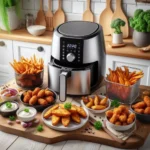Originally posted on 26 March 2024 @ 11:00
Does An Air Fryer Use Less Electricity Than A Toaster Oven
As a culinary enthusiast eager to prepare delicious meals for my family while also keeping an eye on expenses, I’ve found myself at a crossroads – should I stick with my reliable toaster oven, or is it time to invest in an air fryer for potentially greater electricity savings? Both appliances are convenient for quick culinary tasks, such as warming up leftovers or making frozen snacks crisp.
Embarking on a mission to uncover which device is more energy-efficient, I transformed into a veritable Sherlock Ohms, delving deep into the mechanics of both appliances. Here’s the insight I gained in my pursuit to identify the option that uses less power.
How Do Air Fryers Crisp and Cook So Quickly?
Air fryers are basically tiny convection ovens with a supercharged fan that blasts hot air around the food at lightning speed. The small chamber size allows the air to heat up rapidly and surround foods from all angles. It’s like a hairdryer hot air massage for your chicken nuggets!
Most air fryers range from 1200-1500 watts. Some itty-bitty models can be as low as 1000 watts, while bigger capacity fryers go up to 1800 or 2000 watts. My medium-sized one runs at 1400 watts.
Toaster Ovens Rely on Old Faithful Heating Elements
Toaster ovens use tried-and-true electric heating elements positioned on the top and bottom to heat food placed between them. Many also have a fan to help circulate the warm air around for even cooking. The bigger interior fits larger quantities of food or bigger items like pizza, cookies, and whole chicken breasts.
Toaster ovens vary wildly in wattage depending on size and capabilities. Basic small units start at 1000 watts, while suped-up ovens meant to replace full-sized stoves can be 1800+ watts. The average toaster oven is probably 1200-1400 watts—similar to mine.
Is Watts the Whole Story for My Appliances?
OK, so it seems my air fryer and toaster oven are in the same wattage ballpark. But wattage alone doesn’t determine energy vampirism! You have to consider how long the appliance runs, too.
This is where air fryers shine brighter than a new penny. The focused hot air lets most foods cook much faster than a toaster oven would take. We’re talking around 25% less time for many eats.
Case in point – frozen pizza rolls take me only 12-14 minutes in the air fryer but drag on for 18+ minutes in my toaster oven. That adds up to big energy savings for the team air fryer!
More Factors That Can Tip the Energy Scales
Of course, your specific cooking times and electricity costs will depend on other factors like:
Size Matters: Bigger appliances use more juice overall.
Features:– The more bells and whistles, the more energy is used.
Usage habits: A lightly filled air fryer will sip less power than a stuffed one.
Age ain’t just a number: Older appliances tend to be less efficient.
Air fry mode: Some toaster ovens now have a special “air fry” setting that may change the math.
Tips to Save Energy While Cooking
No matter which small appliance you use, there are easy ways to cut down the energy required:
- Cook in small batches to avoid cramming them full
- Skip preheating if you really can
- Use convection mode on your toaster oven
- Clean appliances regularly for max efficiency
- Size pans to match the amount of food
- Use built-in timers and auto shut-off
- Microwave first to reduce appliance time
- Cover foods with foil or lids to hold heat
The Electrical Verdict: Which Is More Energy Efficient?
Based on all my digging, air fryers are generally a bit more energy efficient than toaster ovens thanks to their speedy cook times. But for most home cooks, the annual energy cost difference is probably negligible – maybe $5-10 bucks.
If you use smart power practices, you can minimize electricity with either appliance. For me, convenience, size, and versatility matter more than the small energy savings when choosing which gadget to use.
FAQs
How much juice does an air fryer gulp per hour?
For a medium 1500-watt fryer running full blast, it’ll use around 1.5 kWh (kilowatt hours) per hour. That’ll cost roughly 18 cents based on average electric rates.
What about toaster ovens – how many kWh per hour?
A typical 1400-watt toaster oven uses approximately 1.4 kWh if you run it nonstop for 60 minutes. That comes out to around 17 cents an hour for most folks’ utility rates.
Do small or large appliances need more power?
More giant air fryers or toaster ovens with higher wattages use more total electricity for cooking due to having more interior space to heat up.
Should I freak out about a “vampire” energy draw?
Modern versions of these appliances have very minimal standby power usage when plugged in but turned off. Unplugging can save you a buck or two a year if you want to go, full vampire slayer!
What makes an energy-efficient appliance?
Look for the Energy Star logo, lower wattages, and reviews confirming real-world electricity savings compared to similar models.
Do “air fry” modes on toaster ovens save energy?
They’re designed to be more efficient but it varies, so check reviews and specs to see if a particular toaster oven’s air fry setting cuts electricity use.
Conclusion
For this home cook, air fryers and toaster ovens both earn a passing grade when it comes to energy savings versus firing up my full stove or oven. Air fryers have a slight edge – but it’s not a massive difference.
I’ll focus on choosing the right size appliance for my family’s needs and using energy smarts to save power. With my new kitchen gadgets, I can cook up Quick meals and snacks while keeping my electricity bill in check. Now that’s something to get cooking with!

I’m Ian Welkins, a seasoned professional in the kitchen industry. My passion now drives me to provide invaluable insights into the world of top-notch kitchen products. With years of hands-on experience, I’m your go-to source for culinary excellence.











